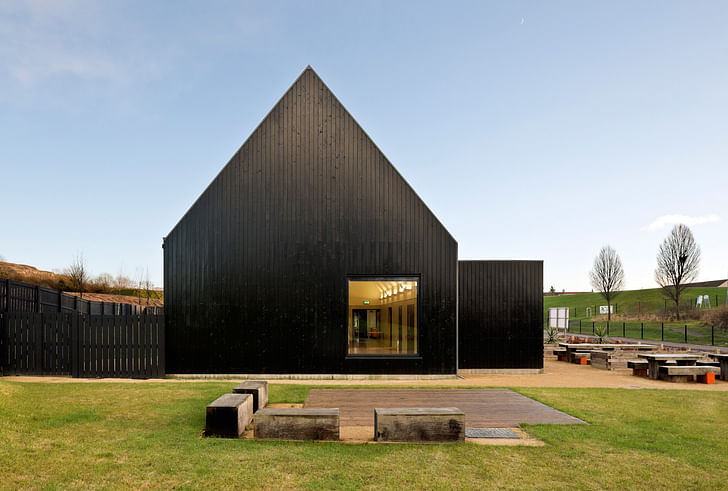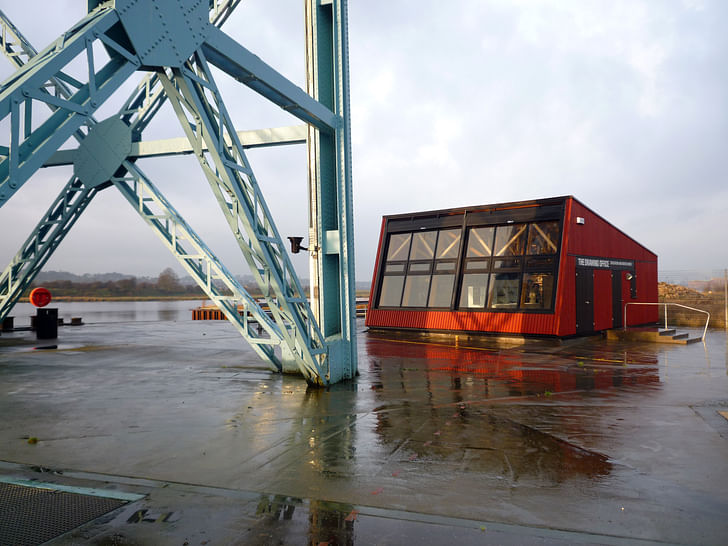

Glasgow-based Collective Architecture was founded in 2007. In what can now be heralded as a great strategic move, former owner Chris Stewart decided to transfer company ownership from himself – after a successful ten year run as Chris Stewart Architects – to an employee-owned trust. Now operating with 34 staff, all pulling together, the trust is not just that of finance but of principle and practice.
I’m in their office on the top floor of a red brick, former industrial building, in the evocatively named Merchant City of Glasgow’s East End.
The studio has an art school vibe, perhaps partly down to the fact that many of the staff are former, or current, staff at Strathclyde University or “The Mac”, the Glasgow School of Art. Indeed, many of the staff are former students of the colleges. The studio could be a “finishing school” without end. The office manager, Jane Briggs, explains to me that no one has ever left Collective Architecture, yet many have come.

I’m here to speak to whoever’s around, there’s no hierarchy here. Jane Briggs sits in on the interview and I’m first introduced to architect Michael Dougal. A staff member for nine years and former graduate of Strathclyde University (and student of Chris Stewart), Dougal is currently at the end of a two-year presidency of the Glasgow Institute of Architects.
What we have, is a studio of architects that want to express their own interests.We start by talking about the transition from a traditional business model to staff-owned trust. “Chris built the practice up to 15 people, that’s when it became a collective,” explains Dougal. “From there, those 15 people were given freedom because they needed that freedom to go out and engage with new clients and develop their own interests. That process that has grown the body of work.”
”The body of work now extends all the way through the public sector, from the Scottish government, through to countless local councils, housing associations and trusts. Their scope includes residential, community, cultural, conservation and, for private clients, commercial. Much of the work is local to Glasgow yet the portfolio is eclectic in aesthetic and scale.

“There’s no one project that sums us up,” agrees Dougal. “There’s such a range; we’ve found ourselves in recent years realising that we don’t have a ‘house style’. What we have, is a studio of architects that want to express their own interests.”

Recently, one studio became two with the opening of a smaller studio in Edinburgh. The addition came about by way of a new project at the City Observatory on Calton Hill in the city, to house the contemporary arts organisation Collective. The project takes over from where, the now defunct, Malcolm Fraser Architects left off to carry the project through delivery.How do we keep what’s great about this studio whilst opening new offices? It’s always about asking ourselves ‘can we be sustainable in the future?’
A casualty of the hard-biting recession, Malcolm Fraser Architects went into liquidation last August, after 22 years, much to the shock of many. How will Collective Architecture achieve a balance between growth, financial stability and a sense of community?
“I think that's the question," says Dougal. "How do we keep what’s great about this studio whilst opening new offices? It’s always about asking ourselves ‘can we be sustainable in the future?’ It's a great debate, it's about how we grow really, it's whether we become more corporate…"
What’s the creative vision for the studio? “I think we’re almost there,” says Dougal. “We’re rebuilding parts of the city, we’ve got a housing project on in Ibrox, and we’ve got significant cultural projects, whilst maintaining some of the smaller community focused stuff which has always been an interest”


If a large practice like Malcolm Fraser Architects found it impossible, then what must it be like for smaller ones? Talking about his role as President of Glasgow Institute of Architects, Dougal notes, “I chaired a meeting of small practices and sole practitioners two weeks ago, trying to set up a network of them, they still find it tough because of procurement issues. They are restricted in the work they can do, unless you have some very serious connections in order to get around things, unless you can provide previous experience, you can find it very difficult to get through that process.”
it was quite nice starting on a project without a preconceived idea, you’re building it up through a pragmatic responseBefore he leaves the table Dougal then goes on to talk about the closeness that the studio feels towards the colleges in the city, pointing out the team members that are walking through the space, that teach. Dougal is keen to, as he says, “give something back” to the community. Jane Briggs points to the fact that the studio takes on apprentices, one of whom came as a school leaver before heading to university to study architecture.
I’m then joined by architect Ewan Imrie to discuss of the studio's latest projects, the £5 million, 12,000-square foot Briggait Creation Centre, a short walk away from Collective Architects, near the bank of The River Clyde. The centre with be the first dedicated public base for dance and Scotland’s first purpose-built accessible space for disabled dancers, and will also cater to physical performance.

“The brief was for a creation centre,” explains Imrie, “which is a kind of European concept of buildings that emerge to facilitate street performance and cross-disciplinary working: people coming together to do weird and wonderful things. In Europe it happens in quite ad hoc ways, in semi-derelict buildings that are almost squatted, emerging as creation centres. There is a slight unusualness in a planned one, normally they are quite an organic process.”
How did they win the brief? “We pitched for it but it didn’t involve a design,” notes Imrie, “Normally you’ve got a design idea that you put forward, so it was quite nice starting on a project without a preconceived idea, you’re building it up through a pragmatic response, thinking about access and how we function and operate.”
What inspiration did Imrie take in? “I used to be a visual artist, I’ve seen ad hoc making spaces, places that inspire activities. You don’t want to impose too much architecture on it, I was thinking about things in terms of how we arrange it and make it visible," says Imrie.

We talk of European influence on Scotland, which is greater than those south of the border may like to imagine. Does the studio get out of Scotland much?
“We took our work down and had a pop-up container that we rented for the weekend at Carl Turner Architects’ POP Brixton,” says Briggs. “A lot of young London architects passed through. We’d thought we were the small fry, from Scotland, but actually, what they were so impressed about was the huge scale and the variety of work. I think in London it’s quite You have to be careful of what you wish for, I tend not to wish. We are open minded enough to tackle unusual projects.hard, you become niche. The message was we are lucky because we do have that variety and we’re not pigeonholed.”
Asked if there is anything beyond the geography of the situation Briggs adds, “We’ve been lucky; though we did get stuck a little bit in housing and we did try to get away into healthcare and we've struggled to get into any education projects. However, we’ve had a few lucky breaks in the cultural sector. It's definitely the way we’ve been working that got us the lucky breaks.” On types of projects the studio may go for in the future, Imrie adds, as a final thought, “You have to be careful of what you wish for, I tend not to wish. We are open minded enough to tackle unusual projects.”
We finish off talking about the locale and the studio’s take on the city, from an architect’s point of view. Briggs talks about the explosion of smaller practices that have been set up by architectural graduates in the wake of the recession. I note that Merchant City seems to be an enclave of architectural practices, as I’d walked directly around the corner from an appointment with Page \ Park Architects, a five minutes walk away. Briggs agrees, rent is kinder on this side of town, but then we’re in the neighbourhood that mixes in one of the poorest parts of the city, where life expectancy for men is just 54 years old.

The work that Collective Architecture does for local and national government is a testament to the local authorities' commitment to making Glasgow, and Scotland, a better place. By assigning a trust to his team, Chris Stewart allowed for collective freedom. That freedom has led to a strong relationship with the authorities. Dougal, through his experience at Collective Architecture, sees the need to equip smaller practices with the skills needed to negotiate with government authorities in order to regenerate the city. Imrie is approaching projects pragmatically, absorbing communities, counter-cultures and artistic values and turning them into manageable projects. And Glasgow is all the better for it.
Robert studied fine art and then worked in children's television as a sound designer before running an art gallery and having a lot of fun. After deciding that writing was the overruling influence he worked as a copywriter in viral advertising and worked behind the scenes for branding and design ...
No Comments
Block this user
Are you sure you want to block this user and hide all related comments throughout the site?
Archinect
This is your first comment on Archinect. Your comment will be visible once approved.